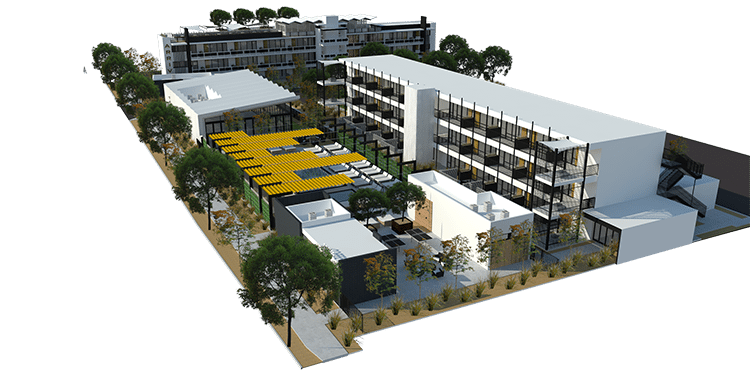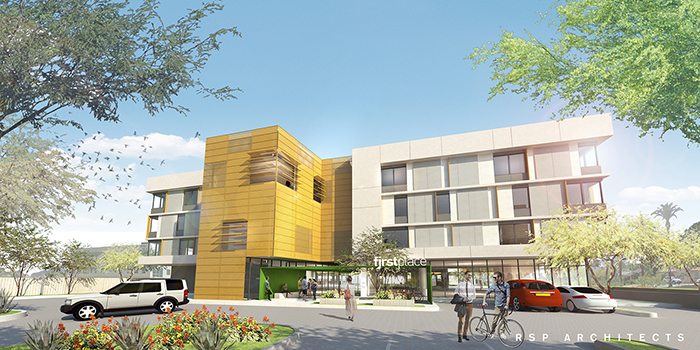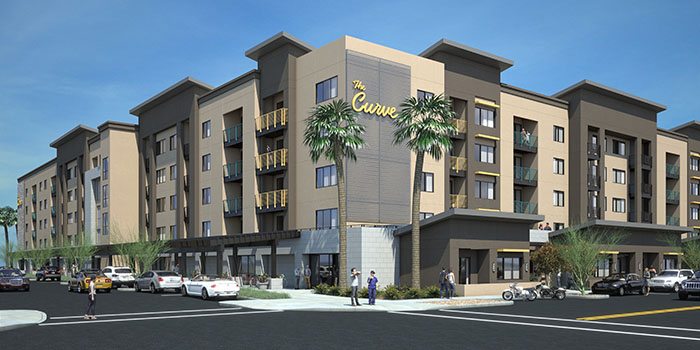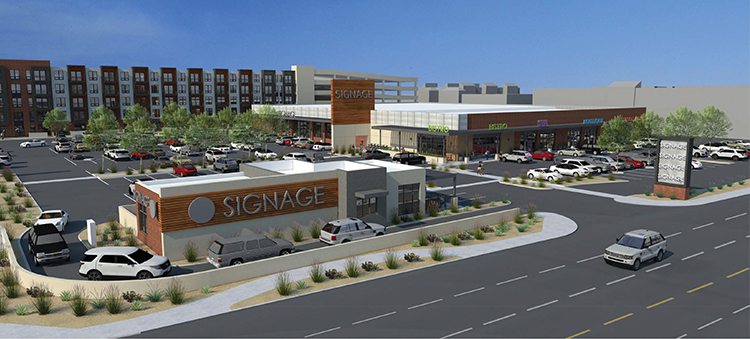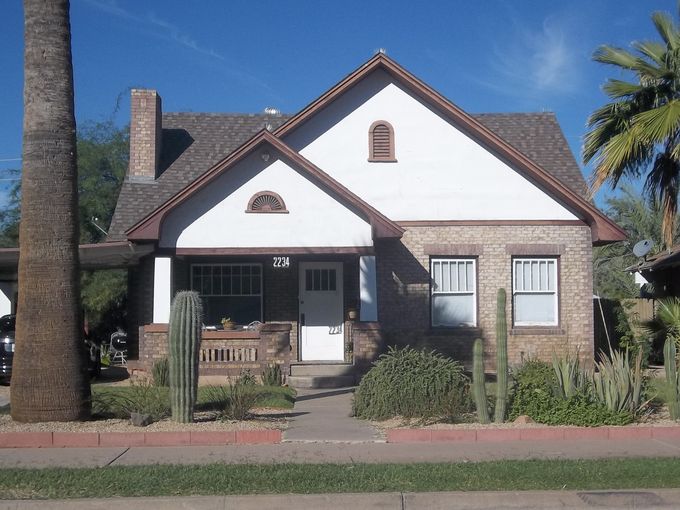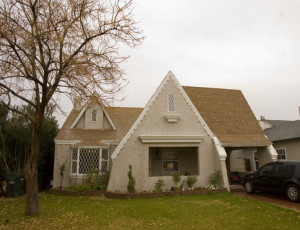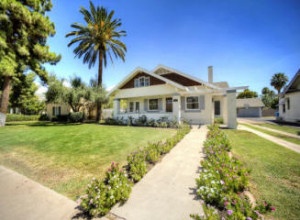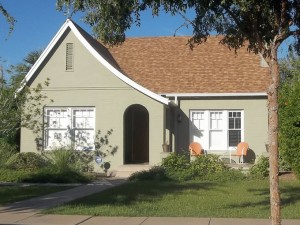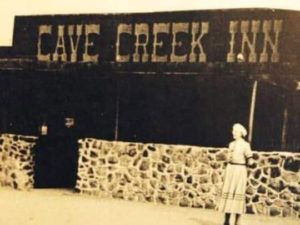As a result, Eastlake Park was comprised almost entirely of black-owned businesses, churches, and schools such as Tanner Chapel A.M.E. Church and the Booker T. Washington School (now occupied by Phoenix New Times). It also bore witness to many of the historic milestones made by African-Americans in Arizona during the 20th century, including speeches by Booker T. Washington in 1911 and Martin Luther King Jr. in 1965, the founding of Arizona’s first African American-owned newspaper, the Phoenix Tribune, and the founding of the Booker T. Washington Hospital in 1927 by Phoenix’s first African-American physician, Dr. Winston Hackett.
As the Civil Rights movement gained momentum in Phoenix during the 1940s, Eastlake Park became a hotbed for protests against inequality and discrimination. But progress was slow, and by the 1960s, Eastlake Park had begun to change. Housing started to deteriorate, residents who could relocate did, and business development waned, leaving the area in a less than ideal state.
In 2013, Eastlake Park underwent a $4 million renovation to upgrade its facilities. This past spring, Eastlake was one of nine communities selected to participate in the inaugural AZ Creative Communities Institute, a collaborative program for improving communities through creative efforts.
“Eastlake is one of the few truly diversified urban neighborhoods being redeveloped with a history of leadership and community involvement.” says Virgil “Jackie” Berry, one of the team members chosen to represent Eastlake Park in the AZ CCI grant.
The Eastlake AZ CCI team notes that while the neighborhood is experiencing positive change in recent years, it’s been at an inconsistent pace. Still, they’re working to explore ways they can create a better environment for the Eastlake community while at the same time memorializing the area’s past, because at the end of the day they all agree, “Eastlake is the soul of the city of Phoenix.”
Squaw Peak Groves In Central Phoenix
Boundaries: 12th Street, 12th Place, Glenn Drive, and the Arizona Canal
Median home price: $423,900
Origin story: Former citrus groves turned midcentury suburb
Why it’s emerging: Trendy new restaurants, a prime central location, and atomic ranch appeal
If you’re looking for the sweet spot south of Sunnyslope but north of uptown, we’ve got three words for you: Squaw Peak Groves. Tucked between 12th Street and 12th Place, Glenn Drive and the Arizona Canal, this hidden gem of atomic ranch homes built primarily between 1960 and 1962 — is a suburban dream.
Set against the backdrop of Piestewa Peak, this cluster of cul-de-sacs and winding no-outlet drives delivers on generous lots, manicured lawns, and quaint facades that feel familiar to anyone who grew up in Phoenix’s more mid-century developments: breeze-blocks, weeping mortar, and yes, maybe even a pastel paint job here and there. It’s ideal for anyone looking to raise a family without relinquishing that coveted central location.
While there aren’t as many, or any groves as the name would lead you to believe, Luci’s owners Ken and Lucia Schnitzer have been bringing the area’s past front and center with their multi-use space, The Orchard.
Located on a former citrus farm and nursery, presumably the source of the development’s original name, The Orchard features Luci’s second location, Splurge Ice Cream and Candy Shop, and Pomelo, an Italian eatery with a citrus name to pay homage to the neighborhood’s history.
Since its opening in 2016, the generous space has become a hotspot for 12th Street corridor in North Central residents looking for a place to gather with their kids, dogs, and the influx of new neighbors. Actually, The Orchard has become a major selling point for the once-sleepy neighborhood, where Ken Schnitzer says that home values have definitely increased. And he’s not surprised.
“Across the United States, people would build housing developments and then shopping centers would go in there and they’d say okay, there’s a need for shopping centers and open a store and restaurants and they’d come in after. Nowadays, the restaurants and places are there and people want to live in the area. So it’s backwards now. You don’t want to move to central Phoenix if there’s no cool places. But if there’s Luci’s and Stock & Stable and The Yard and Windsor … you want to be there.”
And to Schnitzer’s point, there’s very little for sale in Squaw Peak Groves at the moment. Those that are available are a mix of mint condition grandma-chic and newly flipped homes from investors who knew a good deal when they saw one. Either way, interested buyers are encouraged to keep their eyes peeled because a home in the Groves gets snatched up quickly.
West Side-Clark Addition
Boundaries: Country Club Drive, Date Street, Second Place, and Pepper Place, Mesa
Median home price: $190,000
Origin story: This was Mesa’s first suburban neighborhood.
Why it’s emerging: Although it’s a suburb, West Side-Clark looks nothing like your average Mesa stucco-and-tile fest. After years in limbo, it was finally granted historic status in 2017.
Mesa doesn’t have a reputation for architecture — let alone historic architecture. But a cluster of bungalows and ranches situated just west of the city’s original townsite bucks that stereotype.
With homes built between 1930 and 1958, the neighborhood, known as the West Side-Clark Addition, stands out as Mesa’s first move from an agricultural settlement to the sprawling, third-largest city in Arizona that we recognize today.
“This is the seventh historic district for the city of Mesa, but it could’ve been one of the earlier ones,” says Lauren B. Allsopp, who worked with the city’s Historic Preservation Office to secure the neighborhood’s recognition as an official Mesa Historic District. The former farmland already had landed a spot on the National Register of Historic Places.
Allsopp says West Side-Clark is notable for a couple of reasons. First, it’s a prime example of bungalow and ranch housing that gave Mesa its original architectural style. And second, its residents were passionate about having the neighborhood preserved — even though it took a while to make that happen.
As Allsopp explains it, the process for historical designation began in 2004. But it was shelved when the recession hit and the city temporarily didn’t fill the full-time role of Historic Preservation Officer. (Another city employee served as the acting officer, but had several other responsibilities.) When Allsopp joined the office in 2016 on contract, she was able to help reinvigorate the project.
“It’s not the all-one-color tile roofs that you see today,” Allsopp says. “In the 17 years that passed — believe it or not — the neighborhood hardly changed at all.”
That’s a significant factor in a historic designation. In addition to houses still retaining notable features and materials, there were a few more structures that had aged into historic eligibility — or were resorted appropriately.
“Originally, over on Date, there was a little enclave of row houses that weren’t included, and now they were old enough,” she says. Another home became eligible for inclusion after its owners removed siding that covered original materials used in construction.
Residents worked closely with Allsopp to circulate a petition (which is required by Mesa) to move forward with the historic process. It paid off — and the neighborhood got the preservation nod.
This is the first of what Allsopp hopes will be several preservation success stories for Mesa. She’s working on other projects with the city currently, including a recent analysis of the Nile Theater’s mortar, preservation of the city’s neon signage, and securing grants for other neighborhoods.
Still, she says, West Side-Clark was special because she knows how much work went into it.
“I can show you a bungalow, I can show you a Tudor, and I can show you how people have made it work in the 21st century without ruining the character,” Allsopp says. “This is a neighborhood where you’ll want to walk.” B.B.
Garfield Historic District
Boundaries: Seventh Street, 16th Street, Van Buren Street, and Roosevelt Street
Median home price: $269,000
Origin story: Former farmland turned booming middle-class residential development in the early 20th century.
Why it’s emerging: An influx of hot new restaurants and boutiques, a downtown Phoenix resurgence, and still somewhat affordable historic housing.
Tell native Phoenicians — your parents, for example — that you’re looking at houses in the Garfield district, and they might do a double take. That’s because up until very recently — say, the last five years — the historic downtown Phoenix hood had seen better days. Early 20th-century homes had fallen into either poorly stuccoed despair or complete disrepair. Historic storefronts sat abandoned. And despite the heavy foot traffic of the revitalized Roosevelt Row arts district just a block away, Garfield remained more or less a ghost town for downtown visitors.
That wasn’t always the case. In its heyday, Garfield was a thriving residential development bound by what is now Seventh and 16th streets and Van Buren and Roosevelt streets. Between the 1910s and 1920s, approximately 500 houses were built to meet the demands Phoenix’s early population boom — a growth spurt attributed to the 1911 completion of the Roosevelt Dam. By 1935, 85 percent of the former farmland had been converted into housing, offering up a selection of bungalow, Craftsman, Spanish Colonial Revival, Tudor, and English Cottage-style homes to primarily middle- and working-class families.
Not only did the neighborhood give residents direct access to the then-essential Phoenix Street Railway, it also offered an assortment of conveniently located commercial spaces: churches, groceries, even a pharmacy. That same pharmacy, now an indoor plant nursery called Pueblo, is just one of the spaces that has seen new life in recent years, thanks in part to downtown’s resurgence as a whole.
“I just wanted to be as close as possible to my own house,” says Michael Lanier, Garfield resident and Pueblo owner. “I wasn’t trying to focus on opportunity. I was just trying to improve the area where I live for the residents and myself.”
Lanier isn’t alone. At the same intersection of 10th and Pierce streets, businesses including Gallo Blanco and Welcome Diner are also laying down roots, bringing with them an influx of hipsters, foodies, and home buyers who aren’t afraid to get their hands dirty. Throughout the neighborhood, construction is in full swing, and homes that were once selling well under $200,000 just last year are now going for roughly double the price.
Despite its seemingly overnight popularity, however, Lanier is reluctant to label Garfield as the next big thing. “There’s a really fine line with that, to call it emerging. But it really is on sort of a come-up. I think a lot of the residents that have been here five, 10, 15, 20 years have always appreciated it and have wanted it to be better in the sense that anything could be better.”
Like any homeowner who wants to have his cake and eat it, too, Lanier just hopes that Garfield’s newfound attention doesn’t take away from the initial charm and affordability that initially drew him and others to it. “It’s improving greatly. And hopefully that starts working out for the both longtime residents and new [ones],” he says. K.J.
Brentwood Historic District
Boundaries: 16th Street, 20th Street, Brill Street, and Culver Street
Median home price: $199,000
Origin story: Former farmland turned early-20th century residential development
Why it’s emerging: Affordable historic housing, a central Phoenix location, and a influx of new restaurants and shops along the neighboring Miracle Mile.
If you’ve ever driven by the modest remnants of Phoenix’s once-thriving Miracle Mile — a generous strip of storefronts along McDowell Road that served as a prominent shopping destination in the 1950s — chances are you’ve passed its even less-assuming historic neighborhood, Brentwood. Nestled between 16th and 20th streets and Brill and Culver streets, this freeway-adjacent residential area has remained, for the most part, undisturbed, thanks to its limited-access streets.
With its collection of 19th- and 20th-century revivals, including Tudor, Southwest, Spanish Colonial, and bungalows, Brentwood offers a vibe not too dissimilar from more established historic neighborhoods, but without the gentrified price tag.
Like other neighboring districts, Brentwood homes began as farmland, but thanks to Phoenix’s transportation growth and a population that doubled roughly every decade between 1900 and 1940 (it quadrupled in the 1950s) the area was platted for residential development beginning in 1924. By the time of its completion in 1956, Brentwood was composed of six subdivisions — McDowell Heights, Brentwood, Brentwood East, Wright Davis, Valley of the Sun, and Governor Hunt Tract. However, a good portion of the neighborhood later had to be razed to make way for the construction of State Route 51 and Interstate 10.
Still, despite some patchy areas, the neighborhood maintains its historic charm and a central location thanks to its proximity to the concentration of topnotch Mexican dining along 16th Street and of course the Miracle Mile, which, according to residents and business owners, is poised for a comeback. Actually, some of Phoenix’s more popular restaurants and retailers have set up shop along the McDowell corridor over the last few years, including Tacos Chiwas, Ollie Vaughn’s, and Rubymint General Store. Artists like Emily Costello and Kathy Cano-Murillo have arrived, too.
When asked if the area is gearing up for a resurgence, Rubymint General co-owner Kui Mi Oh is hopeful. “[It] used to be the main drag back in the day, so it would be nice to revitalize that. There’s a lot of businesses that have been trying to move on the Miracle Mile, so revamping it would definitely be a plus for us, and I think for the neighborhood as well.”
Aislyn Richmond, McDowell Corridor Coordinator, is working to make it happen. Through a partnership among the Phoenix Community Alliance, Banner Hospital, and Trellia, a nonprofit specializing in affordable housing and community development, Richmond is able to host cleanup events, workshops with businesses in the area to help them succeed, and visioning sessions with residents in Garfield, Coronado, and Brentwood to make sure ideas are being heard.
“The main goal is that [the Miracle Mile] is a very locally focused. So it’s supposed to really serve the neighborhoods here and be community-driven with services that the neighbors can really appreciate while still maintaining the history of the area and bolstering that.”
Garden Apartment District
Boundaries: 68th Street, Fifth Street, Goldwater Boulevard, and First Street, Scottsdale
Median home price: $180,000
Origin story: South of the Hotel Valley Ho, more than 15 upscale garden apartment complexes were built in the mid-20th century. Originally marketed to seasonal tourists, this is a unique collection of multifamily housing that ranges from luxury to kitschy and dramatic.
Why it’s emerging: As housing prices creep up, apartments and condos are once again prime real estate investments. And this particular cluster of apartment buildings has been recommended for historic designation.
Back in the 1950s, Scottsdale was a Hollywood playground. Swanky hotels, new businesses, and tourist attractions set the stage for a multifamily housing boom. One hundred such complexes were built between 1948 and 1964 to accommodate people who wanted to live in the suburb.
The influx came, in part, because of high-level job prospects at Motorola, which announced plans to open a facility in the suburb in the late ’50s.
Nearly 20 garden apartment complexes popped up just south of Hotel Valley Ho, a resort that opened for business in 1956, designed by Frank Lloyd Wright student Edward L. Varney.
Motorola used the hotel to house employees while they looked for permanent residences in the area. And the Valley Ho welcomed entertainers including professional baseball players and the cast and crew of Alfred Hitchcock’s Psycho. Perhaps most notably, Natalie Wood and Robert Wagner hosted the reception for their first wedding in 1957 at the Valley Ho.
It was an exciting time for the suburb, says Ben Brosseau, a Realtor and Garden Apartment District resident. That history and Old Hollywood glamour is what drew the midcentury modern enthusiast and film buff back to Scottsdale after living in Los Angeles for about a decade.
It’s also why he’s working to get the neighborhood a historic designation — something that’s been on hold for a few years.
Brosseau lives at the Shalimar Sands complex, which, alongside buildings like Embassy and Capri, mirrored the designs of destination hotels like the Valley Ho, and the neighboring Safari, which was designed by Al Beadle and later demolished.
“People didn’t just buzz out here for a couple days,” Brosseau says. “They came for a week.”
Those two hotels drew visitors, and demand for Scottsdale rentals skyrocketed. Around the same time, multifamily housing construction was supported by government incentives. Hence, the boom.
Turns out, some of Scottsdale’s garden apartments are architecturally significant for several reasons, according to Steve Venker, Scottsdale’s Historic Preservation Officer. Venker says the district near Valley Ho has one of the best collections of upscale garden apartments in metro Phoenix, and it’s important because of “its use of theme designs and dramatic facades as part of ongoing marketing efforts to attract the seasonal resident.” Also of note is the “range of modern styles, varied use of materials, decorative features, and extra amenities.”
Though a study recommended several of the Garden Apartment District buildings as eligible for historic status, the project was shelved a few years back.
But Brosseau’s taking action. “The city can only get so involved with projects like this,” he says. “They have to wait for people to rally a neighborhood.”
That’s why he’s working to get all the buildings’ homeowners associations on the same page, and he hopes to make major progress next year. Then, they can take more formal steps toward preservation.
Regardless, the neighborhood’s time capsule-like midcentury dwellings are just a hop away from Scottsdale’s arts and entertainment districts. Make that a bike ride, as the city’s recently implemented a bike-share. Brosseau asks, “How great is that?!” B.B.
Warehouse District In Phoenix
Boundaries: Jefferson Street, Sherman Street, Seventh Avenue, and Seventh Street
Origin story: An industrial district and former home of Phoenix’s Chinatown with railroad proximity.
Why it’s emerging: A flood of new businesses, warehouse renovations, and a downtown resurgence.
In major metropolitan cities across the country, warehouses have long been en vogue, operating as clubs, co-ops, studio apartments, and of course industrial chic wedding venues. But like many things our cosmopolitan cohorts have created, Phoenix has admittedly been a little late to the game.
Despite the fact the fifth-largest city does in fact have a bona fide warehouse district — its debated boundaries fall between Seventh Avenue and Seventh Street, Jefferson and Sherman — for decades, urban dwellers and developers were reluctant to recognize the area south of downtown as anything more than storage space and potential parking lots.
Fortunately for these early 20th-century buildings — which have housed everything from wholesale grocers to Phoenix’s now-lost Chinatown — preservationists like Brian Cassidy of CCBG Architects have sought to turn things around. Since constructing their own offices at the corner First and Buchanan streets 12 years ago, the architectural team specializing in, among other things, adaptive reuse, have witnessed firsthand how the warehouse district is making an 11th-hour comeback.
So far, roughly two-thirds of the warehouse renovations have been handled by CCBG architects, including spaces like R & R Partners, The Croft, Grant Street Studios, IASIS Healthcare, Moses Inc, and most recently, the 411 Building, soon to be the home of Scottsdale-based software company Scientific Technologies Corporation.
Cassidy, who’s also Warehouse District chair, says CCBG averages two inquiries a month from businesses looking to move into the warehouse district. But at this point, demand outweighs supply. “Nothing is immediately available. All the space that could be available is going to take anywhere from three months to a year to renovate the buildings.”
So why the sudden rush of ready-to-relocate businesses in the Warehouse District? Cassidy has a few ideas. “We’re seeing that a lot of creative type businesses … their employees are more interested in unique buildings and buildings that you can literally walk out the front door and be out on the street — be close to the restaurants, the entertainment, the bars, and so forth.
Cassidy also credits the warehouse district’s upswing to the catalysts of downtown’s own renaissance: ASU’s downtown campus, the expansion of the Phoenix Convention Center, and Valley Metro’s ongoing light rail expansion, which is set to extend directly through the warehouse district to Baseline Road.
“I always felt that people living in Phoenix wanted a better urban experience but it wasn’t being offered,” he adds.
Now, however, downtown and its subsequent Warehouse District are finally getting the recognition they deserve, thanks to new bars, new restaurants, a grocery store coming in 2018, and a plethora of high-rise residences, including the warehouse district’s first residential development in a decade, set to break ground next year.
“This area’s really going through a resurgence,” Cassidy says. “And if you could fast forward five more years, you’d really be amazed at what’s likely going to happen down here.”
